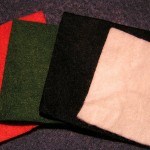Felt is an organic fabric that is produced from wool. The process itself takes a long history, first mention of felt production date to 6500 B.C.  From the ancient history we can proudly claim, that the felt is the oldest fabric known to man. This warm and easily made product was used on wall paintings as the motif of felt applique from 6500 to 3000 B.C in Turkey. Another traces are in the frozen tombs on the north of Siberia and date around 700 B.C. The tribes were producing mainly clothing, saddles, tents. Due to its characteristics, felt tents were strong, water and snow proof, meanwhile inside of the tent it was cozy and friendly.
From the ancient history we can proudly claim, that the felt is the oldest fabric known to man. This warm and easily made product was used on wall paintings as the motif of felt applique from 6500 to 3000 B.C in Turkey. Another traces are in the frozen tombs on the north of Siberia and date around 700 B.C. The tribes were producing mainly clothing, saddles, tents. Due to its characteristics, felt tents were strong, water and snow proof, meanwhile inside of the tent it was cozy and friendly.
The saint patron of felt
As the centuries passed away, felt remained. The Romans discovered process of making felt by a chance, when St. Clement, a wandering monk, stuffed his sandals with a wool to make them more comfortable. The fibers combined with the moisture from sweat and the pressure from his feet produced a fabric, felt. Afterwards, as he was established a bishop, he developed felting process and became the patron of hatmakers, who are working with felt to this day.
Modern ways of production
If we travel to the far East, in Central Asia there are still tribes, that practice feltmaking to produce their tents, traditionally called yurts, clothing, rugs. Currently, the usage of felt is represented in industry as well as in consumer sector. There are 2 main types of processed how is felt produced. Either we are speaking about wet felting or needle felt.
Wet felting
With wet felting, we can use the wool or other animal fibers. The process itself involves the application of warm, soapy water on fibers applied to layers at 90 degree angles to each other until they are hooked together. At the end, the felt material may be finished by fulling. The result is that the felt is thicker and waterproofed.
Needle felt
Compared to the first process, in this one we do not use water. In this case, special needles are used in industrial felting machine. The needles are constructed the way that after each insertion to felt, they hook up together and the result is a fabric, that can be strengthened by chemicals or by steam. This production is much more cheaper that pre previous one, so the most of the felt is produced this way. In this process we can switch the organic wool to synthetic fibers. Clearly, the felt is an irreplaceable product that was proved by centuries and its production was improved to the version that we use these days.